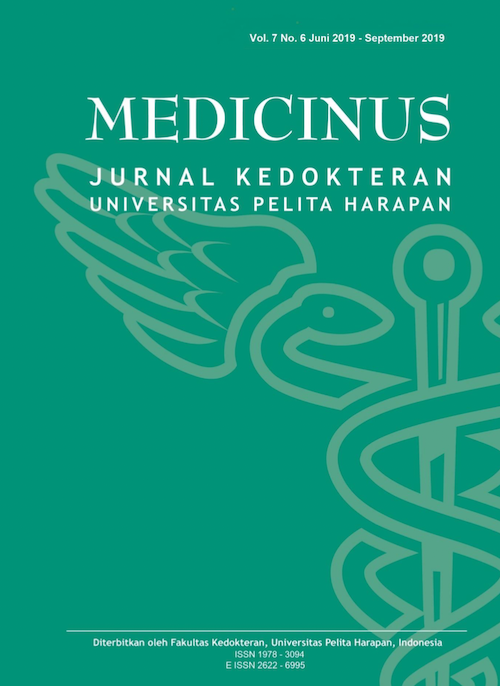Case Series : Operative vs Non-Operative Management in Grade III Pancreatic Injury
DOI:
https://doi.org/10.19166/med.v7i6.2598Keywords:
Pancreatic trauma, Distal Pancreatectomy, PseudocystsAbstract
Introduction: Pancreatic injury is a rare case, caused by blunt or sharp trauma. Difficulty in making diagnose on pancreatic trauma cases are associated with high mortality, and the treatment can be either operative or conservatively. However, It is still unclear which treatment is more favorable.
Case: We present 2 cases of Grade III pancreatic injury with stable hemodynamic who suffered bicycle accident. First case, 12-year-old boy complaining severe pain on the upper left abdomen (VAS 9-10) and get worsening by time, with vomiting. The patient underwent distal Pancreatectomy-Splenectomy. Second case, 8-year-old boy complaining of pain on the upper left abdomen (VAS 6-7) without extension on whole abdominal region with vomiting and fever. The patient was treated conservatively. In both cases, patient was discharged with improvement. However, about 3 months later patients who were treated conservatively developed into a pseudocyst.
Conclusion: The selection of management in grade III pancreatic injury can be operative or conservative depending on clinical findings such as hemodynamic condition and the quality of abdominal pain. But the occurrence of pseudocysts pancreas is another surgical challenge.
References
1. Montalto M., Santoro L., D'Onofrio F., Gallo A., Campo S., Campo V. Endometriosis, need for a multidisciplinary clinical setting: The internist's point of view. Intern. Emerg. Med. 2010;5(6): 463-467. https://doi.org/10.1007/s11739-010-0404-7
2. Giudice L.C. Clinical practice. Endometriosis. N. Engl. J. Med. 2010;362(25): 2389-2398. https://doi.org/10.1056/NEJMcp1000274
3. Macafee C.H., Greer H.L. Intestinal endometriosis. A report of 29 cases and a survey of the literature. J. Obstet. Gynaecol. Br. Emp. 2016; 196067:539-555.
4. Ribeiro P.A., Rodrigues F.C., Kehdi I.P., Rossini L., Abdalla H.S., Donadio N. Laparoscopic resection of intestinal endometriosis: A 5-year experience. J. Minim. Invasive Gynecol. 2006;13(5):442-446. https://doi.org/10.1016/j.jmig.2006.05.010
5. Katsikogiannis N., Tsaroucha A., Dimakis K., Sivridis E., Simopoulos C. Rectal endometriosis causing colonic obstruction and concurrent endometriosis of the appendix: A case report. J. Med. Case Rep. 2011;5: 320. https://doi.org/10.1186/1752-1947-5-320
6. Al-Talib A., Tulandi T. Intestinal endometriosis. Gynaecol. Surg. 2010;7: 61-62. https://doi.org/10.1007/s10397-009-0516-0
7. Ribeiro H.S., Ribeiro P.A., Rossini L., Rodrigues F.C., Donadio N., Aoki T. Double-contrast barium enema and transrectal endoscopic ultrasonography in the diagnosis of intestinal deeply infiltrating endometriosis. J. Minim. Invasive Gynecol. 2008;15(3):315-320. https://doi.org/10.1016/j.jmig.2008.02.001
8. Pramateftakis M.G., Psomas S., Kanellos D., Vrakas G., Roidos G., Makrantonakis A. Large bowel obstruction due to endometriosis. Tech. Coloproctol. 2010;14(Suppl. 1): S87-9. https://doi.org/10.1007/s10151-010-0616-x
9. Harada T., Momoeda M., Taketani Y., Hoshiai H., Terakawa N. Low-dose oral contraceptive pill for dysmenorrhea associated with endometriosis: A placebo-controlled, double-blind, randomized trial. Fertil. Steril. 2008;90(5): 1583-1588. https://doi.org/10.1016/j.fertnstert.2007.08.051
10. Vercellini P., Frontino G., De Giorgi O., Pietropaolo G., Pasin R., Crosignani P.G. Continuous use of an oral contraceptive for endometriosis-associated recurrent dysmenorrhea that does not respond to a cyclic pill regimen. Fertil. Steril. 2003;80(3):560-563. https://doi.org/10.1016/S0015-0282(03)00794-5
11. Miller E.S., Barnett R.M., Williams R.B. Sigmoid endometriotic stricture treated with endoscopic balloon dilatation: Case report and literature review. Md. Med. J. 1990;39(12):1081-1084.
12. Whelton C., Bhowmick A. Acute endometrial bowel obstruction - A rare indication for colonic stenting. Int. J. Surg. Case Rep. 2013;4(2):160-163. https://doi.org/10.1016/j.ijscr.2012.11.007
13. Arafat S., Alsabek M.B., Almousa F., Kubtan M.A. Rare manifestation of endometriosis causing complete recto-sigmoid obstruction: A case report. Int. J. Surg. Case Rep. 2016;26. https://doi.org/10.1016/j.ijscr.2016.07.004
Downloads
Published
How to Cite
Issue
Section
License
Copyright (c) 2020 Andry Irawan, Clinton Clinton, Sutanto D, Agustina F

This work is licensed under a Creative Commons Attribution-ShareAlike 4.0 International License.
Authors who publish with this journal agree to the following terms:
1) Authors retain copyright and grant the journal right of first publication with the work simultaneously licensed under a Creative Commons Attribution License (CC-BY-SA 4.0) that allows others to share the work with an acknowledgement of the work's authorship and initial publication in this journal.
2) Authors are able to enter into separate, additional contractual arrangements for the non-exclusive distribution of the journal's published version of the work (e.g., post it to an institutional repository or publish it in a book), with an acknowledgement of its initial publication in this journal.
3) Authors are permitted and encouraged to post their work online (e.g., in institutional repositories or on their website). The final published PDF should be used and bibliographic details that credit the publication in this journal should be included.





